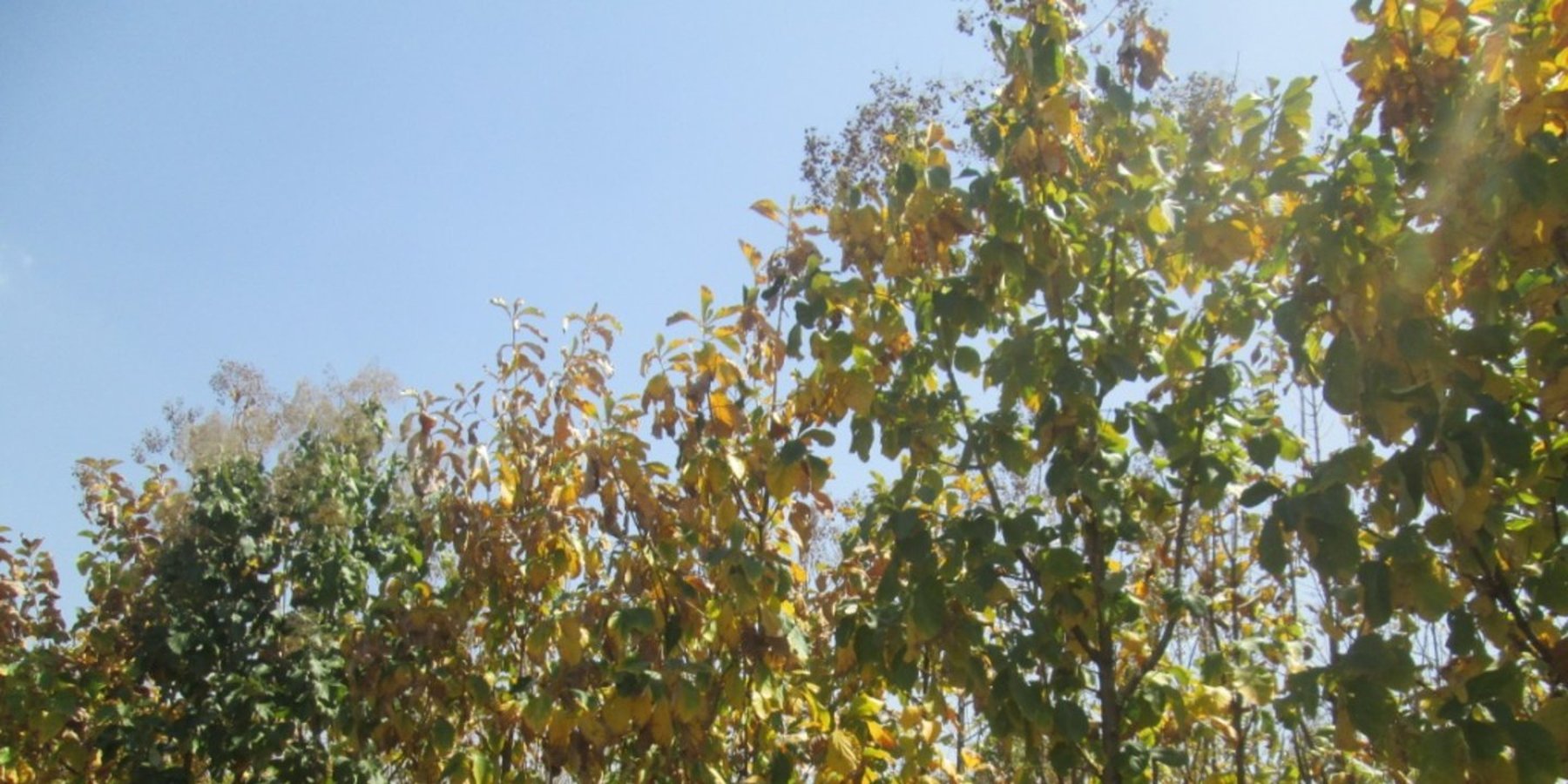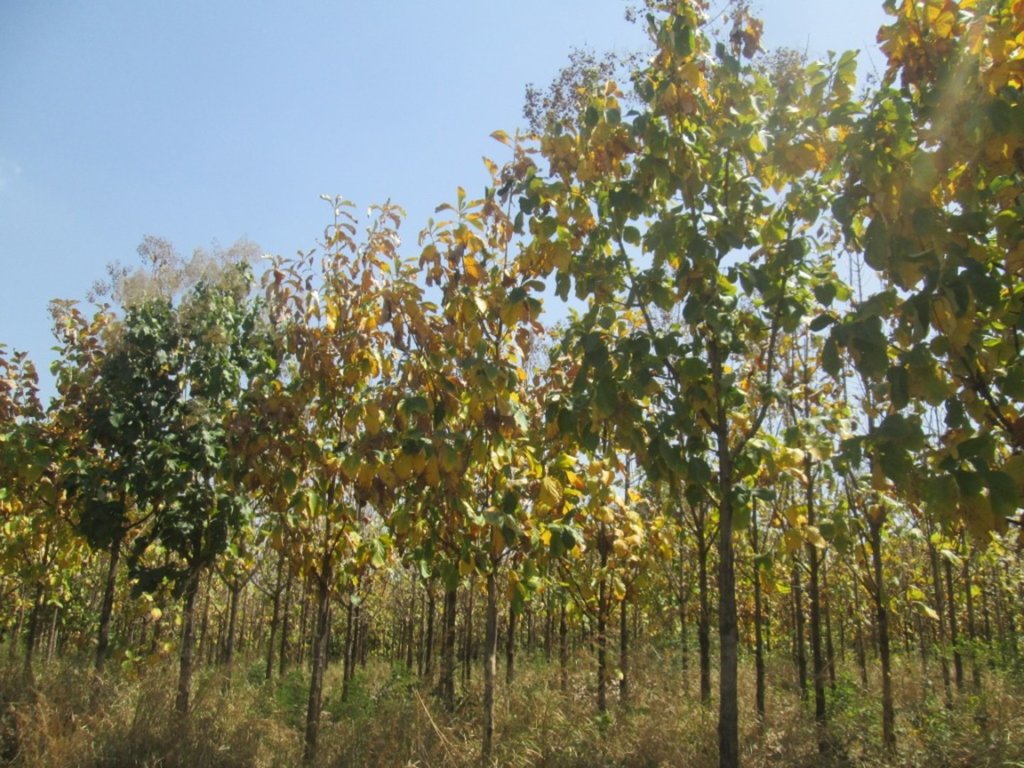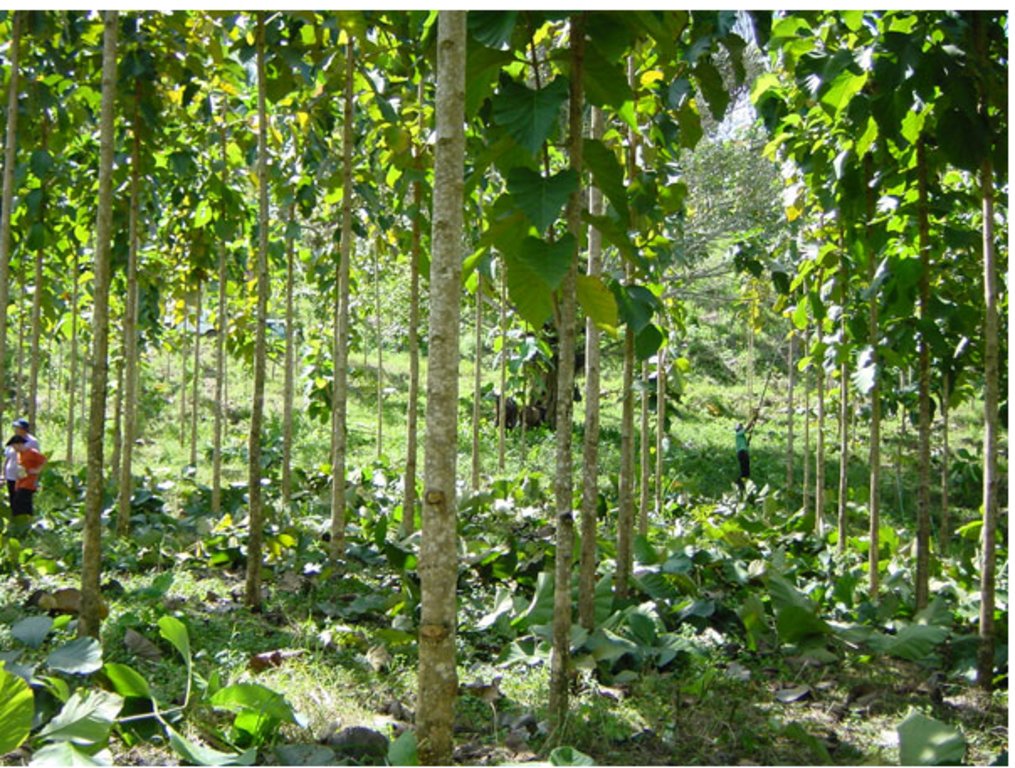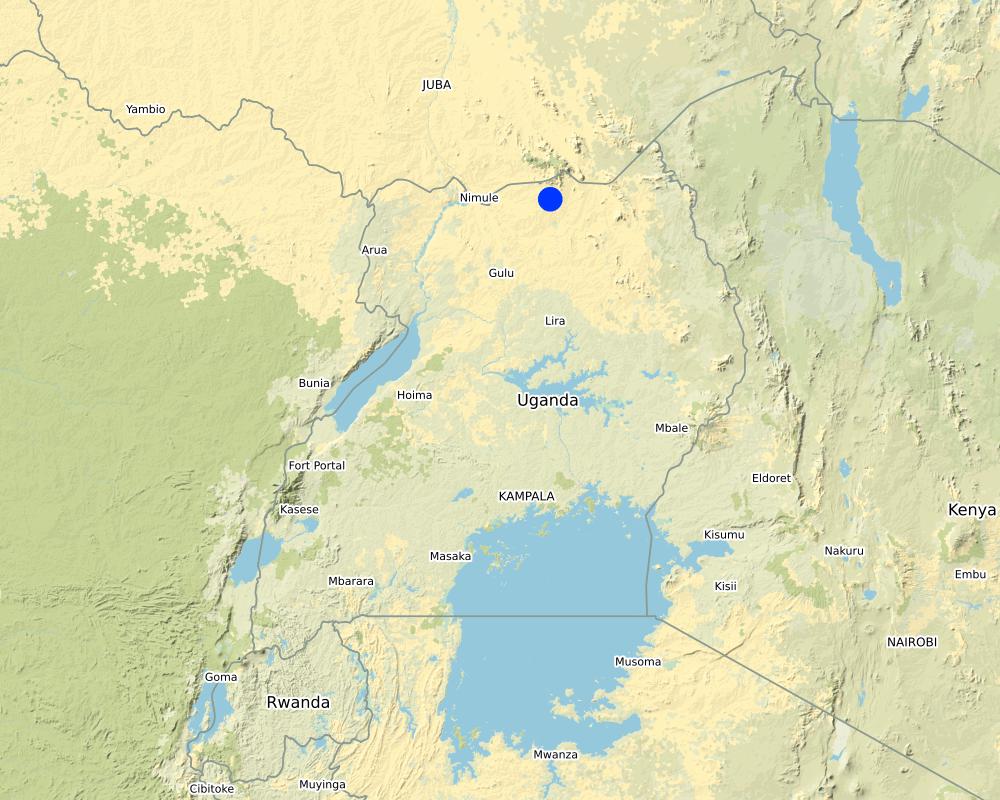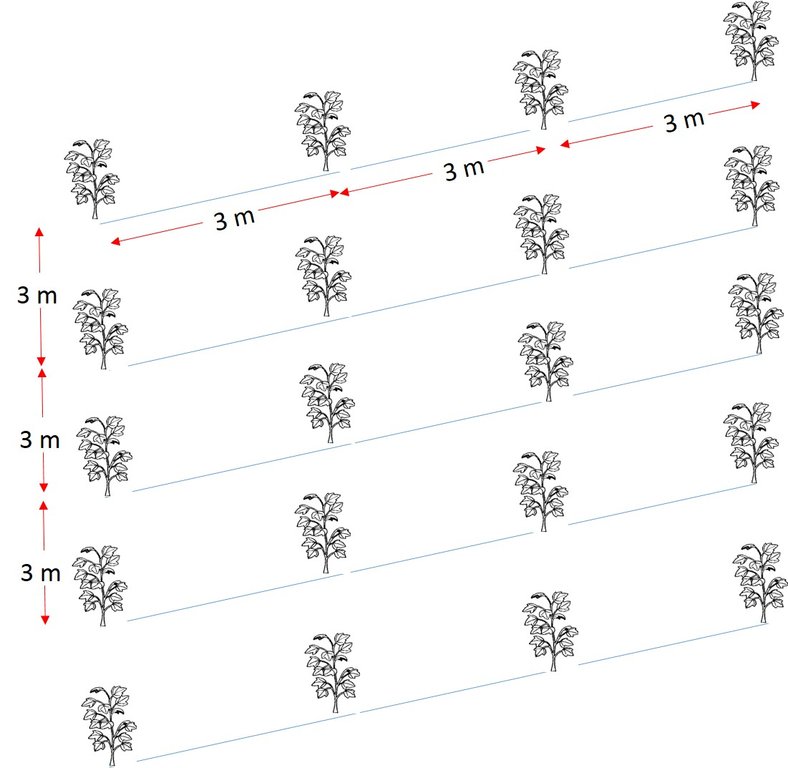Teak-Based Afforestation for Timber Production [Uganda]
- Creation:
- Update:
- Compiler: Bernard Fungo
- Editors: JOY TUKAHIRWA, Kamugisha Rick Nelson, betty adoch, Sunday Balla Amale
- Reviewers: Nicole Harari, Udo Höggel
Bonga teak
technologies_2882 - Uganda
View sections
Expand all Collapse all1. General information
1.2 Contact details of resource persons and institutions involved in the assessment and documentation of the Technology
Key resource person(s)
land user:
Lam Charles
+256789574158
Katom E. B
Patibe sub county. Lamwo district
Uganda
Name of project which facilitated the documentation/ evaluation of the Technology (if relevant)
Scaling-up SLM practices by smallholder farmers (IFAD)Name of the institution(s) which facilitated the documentation/ evaluation of the Technology (if relevant)
CDE Centre for Development and Environment (CDE Centre for Development and Environment) - Switzerland1.3 Conditions regarding the use of data documented through WOCAT
The compiler and key resource person(s) accept the conditions regarding the use of data documented through WOCAT:
Ja
1.4 Declaration on sustainability of the described Technology
Is the Technology described here problematic with regard to land degradation, so that it cannot be declared a sustainable land management technology?
Nee
2. Description of the SLM Technology
2.1 Short description of the Technology
Definition of the Technology:
Teak (Tectona grandis) is preferred as a timber species in northern Uganda because the tree species better endures drought conditions compared to other species such as Pine. A tree plantation of Teak is established mainly to provide timber but also sequester atmospheric carbon and act as wind break.
2.2 Detailed description of the Technology
Description:
Drought-tolerant Teak (Tectona grandis) is suitable for planting in semi-arid areas. In northern Uganda, farmers are establishing plantations of Teak for timber production as opposed to other plantation species like Pines and clonal Eucalyptus.
Seeds are raised in pots, small seedling containers in which they grow into seedlings. When the rains start, usually around April, or September, the seedlings are planted out, with 1,100 seedlings planted per hectare. Teak trees are planted at a spacing of 3 x 3 meters and thinned at 5 and 9 years to retain approximately 450 trees per hectare. To ensure that the timber produced from the trees does not have knots, pruning is done to remove lower branches as the tree grows. Pruning is normally done starting at the age of 3 years. Like most tree planting projects, framers tend to plan Teak on less productive land, leaving the fertile parts of their land for food and other high-value cash crops.
The cost of establishing a Teak plantations is high in the first 2-3 years but reduces significantly after first thinning. The cost of weeding can be reduced by spot-weeding of seedlings up to age 3 years, after which slashing or spraying with herbicides (usually Round-up) is used for weed control. Wood from thinning is also sold as firewood or construction poles to recover some the establishment costs. Shading of leave by Teak is heavy during the dry season and this causes a risk of fire. Therefore, fire control is done by establishing a fine-line, an open space of 6 meters to separate the plantation into compartments in order to restrict fire from spreading from one part to another part.
Farmers like Teak because it endures dry conditions and can provide high-quality timber. Although not exploited yet, these Teak plantations can be used for carbon trade and further improve the income of the farmer. What farmers do not like about Teak is that unlike several other specie where livestock can be integrated in the plantation, it is not possible for teak because it does not support undergrowth.
2.3 Photos of the Technology
2.4 Videos of the Technology
Comments, short description:
Video on Teak based afforestation in Lamwo District
Date:
12/5/2017
Location:
Lamwo
2.5 Country/ region/ locations where the Technology has been applied and which are covered by this assessment
Country:
Uganda
Region/ State/ Province:
Northern
Further specification of location:
Padibe s/county Lamwo District
Map
×2.6 Date of implementation
Indicate year of implementation:
2012
2.7 Introduction of the Technology
Specify how the Technology was introduced:
- through land users' innovation
3. Classification of the SLM Technology
3.1 Main purpose(s) of the Technology
- adapt to climate change/ extremes and its impacts
- mitigate climate change and its impacts
3.2 Current land use type(s) where the Technology is applied

Forest/ woodlands
Tree plantation, afforestation:
- Monoculture exotic variety
Products and services:
- Timber
- Fuelwood
- Protection against natural hazards
3.3 Further information about land use
Water supply for the land on which the Technology is applied:
- rainfed
Number of growing seasons per year:
- 2
3.4 SLM group to which the Technology belongs
- forest plantation management
3.5 Spread of the Technology
Specify the spread of the Technology:
- evenly spread over an area
If the Technology is evenly spread over an area, indicate approximate area covered:
- < 0.1 km2 (10 ha)
3.6 SLM measures comprising the Technology

vegetative measures
- V1: Tree and shrub cover

management measures
- M5: Control/ change of species composition
3.7 Main types of land degradation addressed by the Technology

biological degradation
- Bc: reduction of vegetation cover
3.8 Prevention, reduction, or restoration of land degradation
Specify the goal of the Technology with regard to land degradation:
- adapt to land degradation
4. Technical specifications, implementation activities, inputs, and costs
4.1 Technical drawing of the Technology
4.2 Technical specifications/ explanations of technical drawing
Seeds of Teack (Tectona grandis) are first raised in a nursery until they are 4 months old
Planting is done at the start of the rainy season (April or September)
Spacing between trees is 3 x 3 meters
Weeding is done by spot-weeding to reduce labour and soil disturbance
Pruning is done starting at the age of 3 years
Thinning is done at 5 and 9 years
4.3 General information regarding the calculation of inputs and costs
Specify how costs and inputs were calculated:
- per Technology area
Indicate size and area unit:
5 Acres
other/ national currency (specify):
Uganda Shillings
Indicate exchange rate from USD to local currency (if relevant): 1 USD =:
3500.0
Indicate average wage cost of hired labour per day:
5000
4.4 Establishment activities
| Activity | Type of measure | Timing | |
|---|---|---|---|
| 1. | Raising seedlings in the nursery | Agronomic | At the start of the establishment of the technology |
| 2. | Land clearing | Management | Once at the start of the establishment of the technology |
| 3. | Pitting and Planting | Management | Once at the start of the establishment of the technology |
| 4. | Weeding | Agronomic | Once every year |
| 5. | Pruning | Agronomic | At age 3 and 7 years |
| 6. | Thinning | Agronomic | At age 5 and 9 years |
| 7. | Protection against fire | Management | Every year |
4.5 Costs and inputs needed for establishment
| Specify input | Unit | Quantity | Costs per Unit | Total costs per input | % of costs borne by land users | |
|---|---|---|---|---|---|---|
| Labour | Raising seedlings in the nursry | Mandays | 120.0 | 5000.0 | 600000.0 | 100.0 |
| Labour | Land clearing | Acre | 1.0 | 200000.0 | 200000.0 | 100.0 |
| Labour | Planting | Acre | 1.0 | 200000.0 | 200000.0 | 100.0 |
| Equipment | Watering Cans | Number | 3.0 | 10000.0 | 30000.0 | 100.0 |
| Equipment | Jerricans | Number | 5.0 | 8000.0 | 40000.0 | 100.0 |
| Plant material | Seeds of Teak | kg | 1.0 | 100000.0 | 100000.0 | 100.0 |
| Construction material | Poles for the nursery | Number | 30.0 | 5000.0 | 150000.0 | 100.0 |
| Construction material | Grass for shading the seedlings | Bundles | 10.0 | 10000.0 | 100000.0 | 100.0 |
| Total costs for establishment of the Technology | 1420000.0 | |||||
4.6 Maintenance/ recurrent activities
| Activity | Type of measure | Timing/ frequency | |
|---|---|---|---|
| 1. | Weeding | Management | Every year |
| 2. | Pruning | Management | At age 3 through 7 years |
| 3. | Thining | Management | At 5 and 9 years |
4.7 Costs and inputs needed for maintenance/ recurrent activities (per year)
| Specify input | Unit | Quantity | Costs per Unit | Total costs per input | % of costs borne by land users | |
|---|---|---|---|---|---|---|
| Labour | Weeding | Acre | 1.0 | 150000.0 | 150000.0 | 100.0 |
| Labour | Pruning | Acre | 1.0 | 200000.0 | 200000.0 | 100.0 |
| Labour | Thinning | Acre | 1.0 | 200000.0 | 200000.0 | 100.0 |
| Labour | Regular patrol for fire protection | Years | 15.0 | 600000.0 | 9000000.0 | 100.0 |
| Equipment | Hoes | Number | 5.0 | 15000.0 | 75000.0 | 100.0 |
| Equipment | Pangas | Number | 5.0 | 8000.0 | 40000.0 | 100.0 |
| Equipment | Pruning saws | Number | 5.0 | 20000.0 | 100000.0 | 100.0 |
| Total costs for maintenance of the Technology | 9765000.0 | |||||
4.8 Most important factors affecting the costs
Describe the most determinate factors affecting the costs:
Raising seedlings and planting
5. Natural and human environment
5.1 Climate
Annual rainfall
- < 250 mm
- 251-500 mm
- 501-750 mm
- 751-1,000 mm
- 1,001-1,500 mm
- 1,501-2,000 mm
- 2,001-3,000 mm
- 3,001-4,000 mm
- > 4,000 mm
Agro-climatic zone
- sub-humid
5.2 Topography
Slopes on average:
- flat (0-2%)
- gentle (3-5%)
- moderate (6-10%)
- rolling (11-15%)
- hilly (16-30%)
- steep (31-60%)
- very steep (>60%)
Landforms:
- plateau/plains
- ridges
- mountain slopes
- hill slopes
- footslopes
- valley floors
Altitudinal zone:
- 0-100 m a.s.l.
- 101-500 m a.s.l.
- 501-1,000 m a.s.l.
- 1,001-1,500 m a.s.l.
- 1,501-2,000 m a.s.l.
- 2,001-2,500 m a.s.l.
- 2,501-3,000 m a.s.l.
- 3,001-4,000 m a.s.l.
- > 4,000 m a.s.l.
Indicate if the Technology is specifically applied in:
- not relevant
5.3 Soils
Soil depth on average:
- very shallow (0-20 cm)
- shallow (21-50 cm)
- moderately deep (51-80 cm)
- deep (81-120 cm)
- very deep (> 120 cm)
Soil texture (topsoil):
- medium (loamy, silty)
Soil texture (> 20 cm below surface):
- medium (loamy, silty)
Topsoil organic matter:
- medium (1-3%)
5.4 Water availability and quality
Ground water table:
5-50 m
Availability of surface water:
good
Water quality (untreated):
for agricultural use only (irrigation)
Is water salinity a problem?
Nee
Is flooding of the area occurring?
Nee
5.5 Biodiversity
Species diversity:
- medium
Habitat diversity:
- medium
5.6 Characteristics of land users applying the Technology
Sedentary or nomadic:
- Sedentary
Market orientation of production system:
- mixed (subsistence/ commercial
Off-farm income:
- 10-50% of all income
Relative level of wealth:
- average
Individuals or groups:
- individual/ household
Level of mechanization:
- manual work
Gender:
- women
- men
Age of land users:
- youth
- middle-aged
5.7 Average area of land owned or leased by land users applying the Technology
- < 0.5 ha
- 0.5-1 ha
- 1-2 ha
- 2-5 ha
- 5-15 ha
- 15-50 ha
- 50-100 ha
- 100-500 ha
- 500-1,000 ha
- 1,000-10,000 ha
- > 10,000 ha
Is this considered small-, medium- or large-scale (referring to local context)?
- small-scale
5.8 Land ownership, land use rights, and water use rights
Land ownership:
- individual, not titled
Land use rights:
- individual
Water use rights:
- individual
5.9 Access to services and infrastructure
health:
- poor
- moderate
- good
education:
- poor
- moderate
- good
technical assistance:
- poor
- moderate
- good
employment (e.g. off-farm):
- poor
- moderate
- good
markets:
- poor
- moderate
- good
energy:
- poor
- moderate
- good
roads and transport:
- poor
- moderate
- good
drinking water and sanitation:
- poor
- moderate
- good
financial services:
- poor
- moderate
- good
6. Impacts and concluding statements
6.1 On-site impacts the Technology has shown
Socio-economic impacts
Production
wood production
forest/ woodland quality
energy generation
Income and costs
expenses on agricultural inputs
farm income
diversity of income sources
workload
Ecological impacts
Climate and disaster risk reduction
drought impacts
wind velocity
6.2 Off-site impacts the Technology has shown
wind transported sediments
6.3 Exposure and sensitivity of the Technology to gradual climate change and climate-related extremes/ disasters (as perceived by land users)
Gradual climate change
Gradual climate change
| Season | Type of climatic change/ extreme | How does the Technology cope with it? | |
|---|---|---|---|
| seasonal temperature | dry season | increase | moderately |
6.4 Cost-benefit analysis
How do the benefits compare with the establishment costs (from land users’ perspective)?
Short-term returns:
negative
Long-term returns:
very positive
How do the benefits compare with the maintenance/ recurrent costs (from land users' perspective)?
Short-term returns:
positive
Long-term returns:
very positive
6.5 Adoption of the Technology
- 1-10%
Of all those who have adopted the Technology, how many have did so spontaneously, i.e. without receiving any material incentives/ payments?
- 90-100%
6.6 Adaptation
Has the Technology been modified recently to adapt to changing conditions?
Nee
6.7 Strengths/ advantages/ opportunities of the Technology
| Strengths/ advantages/ opportunities in the land user’s view |
|---|
| Teak is drought-tolerant and and provides high quality timber which, guarantees profits from the investment |
| Other ecological benefits can be realized from the plantation, such as the role of wind breaks and carbon sequestration |
6.8 Weaknesses/ disadvantages/ risks of the Technology and ways of overcoming them
| Weaknesses/ disadvantages/ risks in the land user’s view | How can they be overcome? |
|---|---|
| The cost of establishing the plantation is high for majority farmers in the area | Community nurseries can provide seedlings to reduce establishment costs |
| The risk of fire during the dry season is very high | Protection against fire has to be considered as part of the investment, to construct fire lines and regular patrols |
7. References and links
7.1 Methods/ sources of information
- field visits, field surveys
2
- interviews with land users
1
Links and modules
Expand all Collapse allLinks
No links
Modules
No modules


